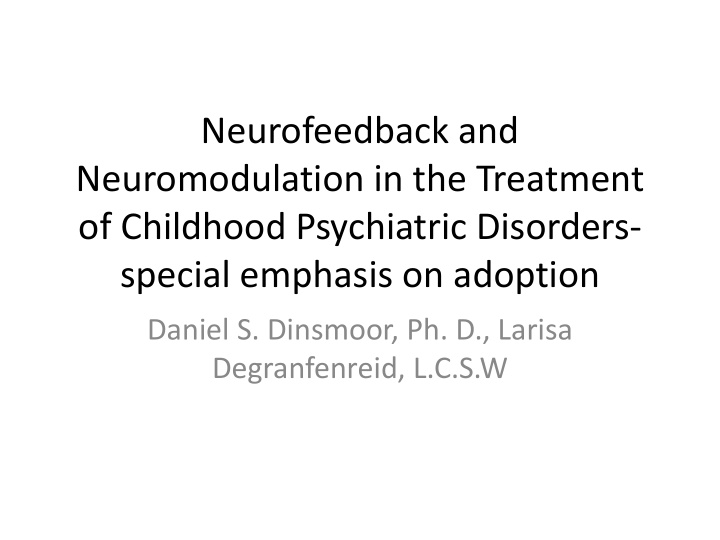



Neurofeedback and Neuromodulation in the Treatment of Childhood Psychiatric Disorders- special emphasis on adoption Daniel S. Dinsmoor, Ph. D., Larisa Degranfenreid, L.C.S.W
Our Backgrounds • Larisa • Dan
What is neurofeedback? • It is the interaction of the person with neurophysiological information from the brain that allows the individual to either consciously or unconsciously control what is happening internally, and by doing so increase the capacity of the brain to do work in the real world.
Two paradigm shifts • Paradigm shift from thought processes to brain dynamics • Paradigm shift from a neurotransmitter understanding of brain dynamics to a Hemodynamic and Bioelectric understanding of brain dynamics.
What kinds of problems do we see with adopted children who come to our clinic? • Problems with attention and learning (getting things done, lack of synchrony in the classroom) • Problems with self regulation- (short fuse) • Problems with empathic attachment (rigidity and ego-centrism) • Instabilities- migraines, panic attacks etc., Bipolar disorder • Acute stress and family relationship problems • Developmental trauma
Additional Problems • Dealing with a non-adopted sibling with serious mental illness problems • The same problems we see everyday with children who are not adopted (anxiety, depression, conduct problems, OCD, etc.), • Pediatric autoimmune neuropsychiatric disorders (PANDAS)
Hypoperfusion of the Frontal Cortex
McGovern Center Video
Why is this important? • Because we can visualize these same processes in a simpler way to provide treatment. • We can see not only how important brain areas are operating, but also brain networks, and how brain networks interact with each other. • This gives us clues as to how to proceed with treatment, and confidence that we are proceeding in a useful way.
PFC temp data as seen by an infrared camera
PFC temp data in a line graph
PFC temp data in a line graph
What are Infra-Slow Frequencies? • Infraslow Oscilations- what are they? • Correlated changes in electrical activity on the same time scale • Palva and Palva on the significance of ISO’s andISF”s • Mark Smith’s description in terms of the ans, attention, etc.
Figure V. CBCL Results, Change on Marker of Primary Concern. CBCL results were available for 12 of the 17 students. The graph above plots the CBCL scaled score for each student's primary area of concern. There was an Average improvement of 16 scaled score points, or 1.6 standard deviations of improvement
Case Studies
Case #1- 5 y.o. boy with problems in self regulation
Presenting Problems • Anxious • Aggressive • Fidgety • Hyperactive • Loss of emotional control • Mood swings • Irritable
Symptom Checklist
Video #4
Second Session
5
7
9
12
14
21
27
Results
Anxious Symptom 1 7 6 5 4 3 2 1 0 1 2 3 4 5 6 7 8 9 10 11 12 13 14 15 16 17 18 19 20 21 22 23 24 25 26 27 28 29 30 Anxious
Fidgety Symptom 2 7 6 5 4 3 2 1 0 1 2 3 4 5 6 7 8 9 10 11 12 13 14 15 16 17 18 19 20 21 22 23 24 25 26 27 28 29 30 Fidgety
Fighting/aggressive Symptom 3 7 6 5 4 3 2 1 0 1 2 3 4 5 6 7 8 9 10 11 12 13 14 15 16 17 18 19 20 21 22 23 24 25 26 27 28 29 30 Fighting/aggressive
Hyperactivity Symptom 4 7 6 5 4 3 2 1 0 1 2 3 4 5 6 7 8 9 10 11 12 13 14 15 16 17 18 19 20 21 22 23 24 25 26 27 28 29 30 Hyperactive
Loss of emotional control Symptom 5 7 6 5 4 3 2 1 0 1 2 3 4 5 6 7 8 9 10 11 12 13 14 15 16 17 18 19 20 21 22 23 24 25 26 27 28 29 30 #REF!
Rapid mood swings Symptom 6 7 6 5 4 3 2 1 0 1 2 3 4 5 6 7 8 9 10 11 12 13 14 15 16 17 18 19 20 21 22 23 24 25 26 27 28 29 30 Rapid mood changes
Summary of treatment • Warm and friendly. • No longer frowny. • “no” is no longer her default position. • Parents put additional supports in place to continue progress already established. • Use of medication has been avoided. • There is a more positive start in terms of personality development
Recommend
More recommend